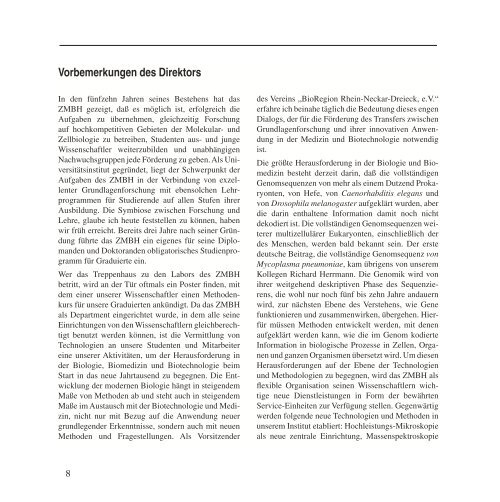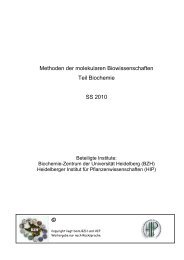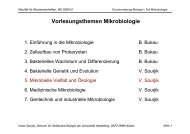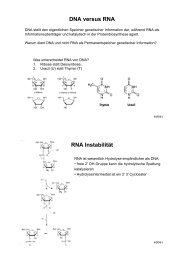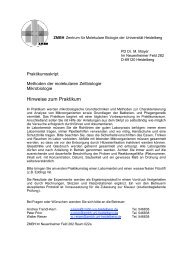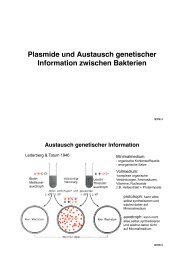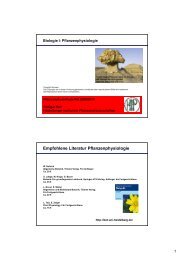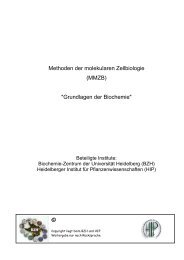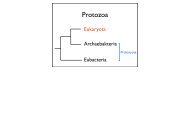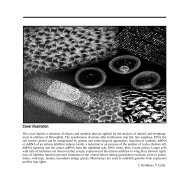ZMBH J.Bericht 2000 - Zentrum für Molekulare Biologie der ...
ZMBH J.Bericht 2000 - Zentrum für Molekulare Biologie der ...
ZMBH J.Bericht 2000 - Zentrum für Molekulare Biologie der ...
You also want an ePaper? Increase the reach of your titles
YUMPU automatically turns print PDFs into web optimized ePapers that Google loves.
Vorbemerkungen des Direktors<br />
In den fünfzehn Jahren seines Bestehens hat das<br />
<strong>ZMBH</strong> gezeigt, daß es möglich ist, erfolgreich die<br />
Aufgaben zu übernehmen, gleichzeitig Forschung<br />
auf hochkompetitiven Gebieten <strong>der</strong> Molekular- und<br />
Zellbiologie zu betreiben, Studenten aus- und junge<br />
Wissenschaftler weiterzubilden und unabhängigen<br />
Nachwuchsgruppen jede För<strong>der</strong>ung zu geben. Als Universitätsinstitut<br />
gegründet, liegt <strong>der</strong> Schwerpunkt <strong>der</strong><br />
Aufgaben des <strong>ZMBH</strong> in <strong>der</strong> Verbindung von exzellenter<br />
Grundlagenforschung mit ebensolchen Lehrprogrammen<br />
<strong>für</strong> Studierende auf allen Stufen ihrer<br />
Ausbildung. Die Symbiose zwischen Forschung und<br />
Lehre, glaube ich heute feststellen zu können, haben<br />
wir früh erreicht. Bereits drei Jahre nach seiner Gründung<br />
führte das <strong>ZMBH</strong> ein eigenes <strong>für</strong> seine Diplomanden<br />
und Doktoranden obligatorisches Studienprogramm<br />
<strong>für</strong> Graduierte ein.<br />
Wer das Treppenhaus zu den Labors des <strong>ZMBH</strong><br />
betritt, wird an <strong>der</strong> Tür oftmals ein Poster finden, mit<br />
dem einer unserer Wissenschaftler einen Methodenkurs<br />
<strong>für</strong> unsere Graduierten ankündigt. Da das <strong>ZMBH</strong><br />
als Department eingerichtet wurde, in dem alle seine<br />
Einrichtungen von den Wissenschaftlern gleichberechtigt<br />
benutzt werden können, ist die Vermittlung von<br />
Technologien an unsere Studenten und Mitarbeiter<br />
eine unserer Aktivitäten, um <strong>der</strong> Herausfor<strong>der</strong>ung in<br />
<strong>der</strong> <strong>Biologie</strong>, Biomedizin und Biotechnologie beim<br />
Start in das neue Jahrtausend zu begegnen. Die Entwicklung<br />
<strong>der</strong> mo<strong>der</strong>nen <strong>Biologie</strong> hängt in steigendem<br />
Maße von Methoden ab und steht auch in steigendem<br />
Maße im Austausch mit <strong>der</strong> Biotechnologie und Medizin,<br />
nicht nur mit Bezug auf die Anwendung neuer<br />
grundlegen<strong>der</strong> Erkenntnisse, son<strong>der</strong>n auch mit neuen<br />
Methoden und Fragestellungen. Als Vorsitzen<strong>der</strong><br />
8<br />
des Vereins „BioRegion Rhein-Neckar-Dreieck, e.V.“<br />
erfahre ich beinahe täglich die Bedeutung dieses engen<br />
Dialogs, <strong>der</strong> <strong>für</strong> die För<strong>der</strong>ung des Transfers zwischen<br />
Grundlagenforschung und ihrer innovativen Anwendung<br />
in <strong>der</strong> Medizin und Biotechnologie notwendig<br />
ist.<br />
Die größte Herausfor<strong>der</strong>ung in <strong>der</strong> <strong>Biologie</strong> und Biomedizin<br />
besteht <strong>der</strong>zeit darin, daß die vollständigen<br />
Genomsequenzen von mehr als einem Dutzend Prokaryonten,<br />
von Hefe, von Caenorhabditis elegans und<br />
von Drosophila melanogaster aufgeklärt wurden, aber<br />
die darin enthaltene Information damit noch nicht<br />
dekodiert ist. Die vollständigen Genomsequenzen weiterer<br />
multizellulärer Eukaryonten, einschließlich <strong>der</strong><br />
des Menschen, werden bald bekannt sein. Der erste<br />
deutsche Beitrag, die vollständige Genomsequenz von<br />
Mycoplasma pneumoniae, kam übrigens von unserem<br />
Kollegen Richard Herrmann. Die Genomik wird von<br />
ihrer weitgehend deskriptiven Phase des Sequenzierens,<br />
die wohl nur noch fünf bis zehn Jahre andauern<br />
wird, zur nächsten Ebene des Verstehens, wie Gene<br />
funktionieren und zusammenwirken, übergehen. Hier<strong>für</strong><br />
müssen Methoden entwickelt werden, mit denen<br />
aufgeklärt werden kann, wie die im Genom kodierte<br />
Information in biologische Prozesse in Zellen, Organen<br />
und ganzen Organismen übersetzt wird. Um diesen<br />
Herausfor<strong>der</strong>ungen auf <strong>der</strong> Ebene <strong>der</strong> Technologien<br />
und Methodologien zu begegnen, wird das <strong>ZMBH</strong> als<br />
flexible Organisation seinen Wissenschaftlern wichtige<br />
neue Dienstleistungen in Form <strong>der</strong> bewährten<br />
Service-Einheiten zur Verfügung stellen. Gegenwärtig<br />
werden folgende neue Technologien und Methoden in<br />
unserem Institut etabliert: Hochleistungs-Mikroskopie<br />
als neue zentrale Einrichtung, Massenspektroskopie<br />
Introductory Remarks of the Director<br />
In the fifteen years of its existence, the <strong>ZMBH</strong> has<br />
proven that it is possible to successfully address the<br />
mission to conduct research in the forefront in highly<br />
competitive fields of molecular and cellular biology, to<br />
educate students, to train young scientists and to give<br />
full support to independent junior groups. Because it<br />
was designed as a university institute, the focus of the<br />
<strong>ZMBH</strong> is to combine basic research with excellent<br />
education programs for students at all levels. Three<br />
years after its inauguration, the <strong>ZMBH</strong> introduced its<br />
own graduate program obligatory for its diploma and<br />
doctoral students.<br />
If you enter the staircase leading to the laboratories,<br />
you may encounter at the door a poster advertising<br />
a practical course held for our graduate students by<br />
one of our faculty members. Because the <strong>ZMBH</strong> was<br />
designed as a department in which resources are open<br />
to the <strong>ZMBH</strong> faculty, transferring technology to our<br />
students and coworkers is just one of our activities to<br />
meet with the challenge in biology, biomedicine and<br />
biotechnology at the start of this new millennium. The<br />
development of mo<strong>der</strong>n biology increasingly depends<br />
on methods and is also increasingly in exchange with<br />
biotechnology and medicine, not only in regard to the<br />
application of discoveries in basic science but also<br />
by the provision of methods and scientific problems.<br />
As chairman of the BioRegion Rhein-Neckar-Triangle<br />
association, I experience almost daily the importance<br />
of having a close dialogue to exchange information<br />
between fundamental research and its innovative<br />
application in medicine and biotechnology industry.<br />
One of the major discoveries of the past years driving<br />
the progress in biology and biomedicine is the fact that<br />
we now know the complete genomic sequences for<br />
more than a dozen prokaryotic organisms as well as<br />
that of yeast, Caenorhabditis elegans and Drosophila<br />
melanogaster. The first contribution of Germany, the<br />
complete genomic sequence of Micrococcus pneumoniae,<br />
came from our colleague Richard Herrmann.<br />
The full genomic sequences of further multicellular<br />
eukaryotes, including humans will soon be known.<br />
Genomics will be passing from a largely descriptive<br />
phase of genomic sequencing, that may only last for<br />
another five to ten years, to the next level of un<strong>der</strong>standing<br />
of how genes function and interact. For this,<br />
methods need to be developed which allow to uncover<br />
how the information encoded in the genome is translated<br />
into biological processes within cells, organs and<br />
complete organisms. To meet the challenges at the<br />
level of technologies and methodologies, the <strong>ZMBH</strong><br />
as a flexible organization continues to provide to its<br />
faculty essential novel services through its powerful<br />
infrastructure of central service units. New technologies<br />
and methods are being presently set up at our<br />
institute: advanced light microscopy as a new central<br />
service unit, mass spectrometry for protein identification<br />
and sequencing within the existing biomolecular<br />
chemistry unit, advanced cell sorting for the selection<br />
and isolation of rare genotypes of transfected eukaryotic<br />
cells and a transgenic Drosophila service as part<br />
of our animal house facility. We are currently discussing<br />
the instalment of a DNA microarray technology<br />
service unit as part of biomolecular chemistry. Microarray<br />
technology that detects mRNA promises to measure<br />
expression of genomes in cells in response to<br />
internal or external signals and is therefore of interest<br />
to most of the <strong>ZMBH</strong> faculty. To meet with the laboratory<br />
space demand caused by the new central services,<br />
we will expand and build space for offices on top of<br />
9


